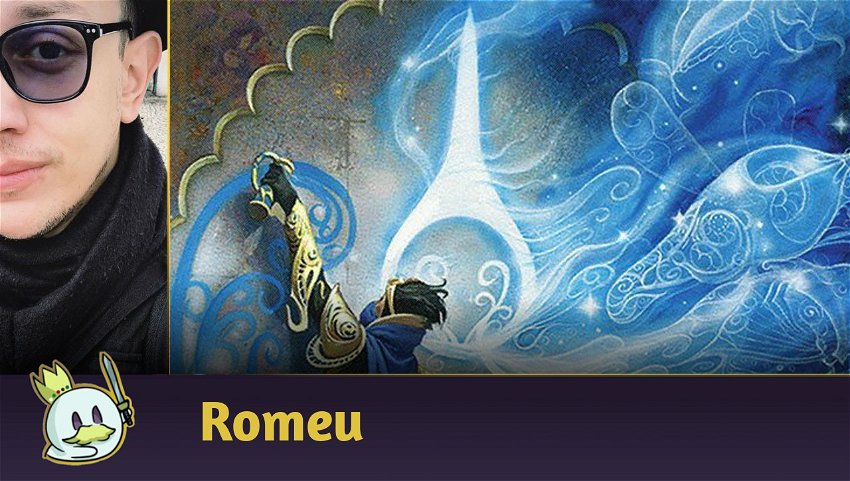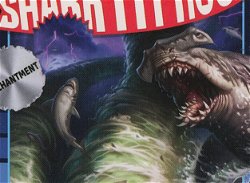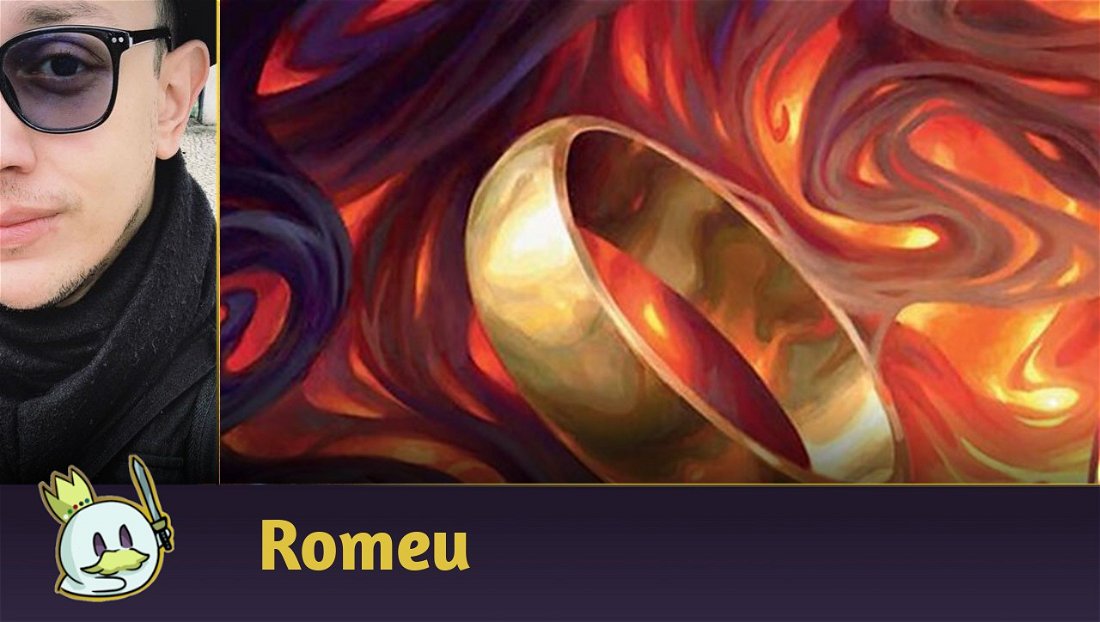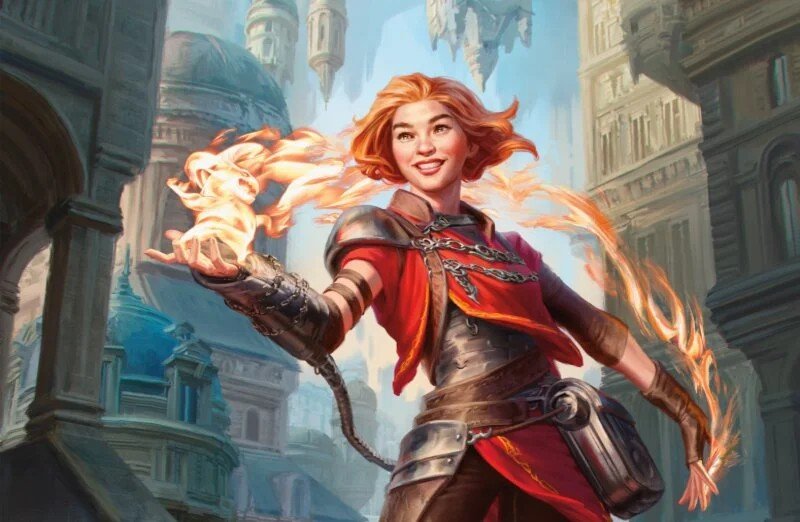A few weeks after the end of Pro Tour: Phyrexia, we can conclude that the event established some changes regarding Pioneer and how the Metagame behaves.
Notable among these are a new Abzan Greasefang shell, more extensive use of Mutavault in the maindeck of assorted archetypes, and the growth in popularity of Izzet Creativity, which will be the highlight of this article.
What is Izzet Creativity?

Izzet Creativity is a combo-control deck focused on having tokens created by spells like Big Score, Secrets of the Key or Shark Typhoon in play to destroy them with Indomitable Creativity and look for a specific combination of creatures:
Ad

The most successful setup today is the one that seeks out Xenagos, God of Revels and Worldspine Wurm whic turns the wurm into a 30/30 creature with Trample and Haste, dealing enough damage to close the game with a single attack. If the opponent has some removal to deal with Worldspine Wurm, unless they exile it, we still have three 5/5 tokens to advance the game and serve as a wincondition in our plan to control the game.
Other combinations include Sage of the Falls and The Locust God, more common in Explorer where both of the above creatures are unavailable, and also a "fair" version with Atraxa, Grand Unifier and/or Hullbreaker Horror, but the essence of Izzet Creativity is basically creating artifacts to put massive threats on the board or close out a combo that will likely win the game.
What makes Izzet Creativity a good choice for Pioneer?
Combo-Control strategies are often the most absurd thing you can do in a competitive format when they lack resources like free spells to thwart your game plan. Historically, Pioneer has lived under this nightmare when Thassa's Oracle enabled the creation of Dimir Inverter, which, along with two other combo decks, dominated the Metagame for months until direct intervention was taken.

What makes a Combo-Control so difficult to interact with is that it usually interacts better than you on many occasions, as it usually needs only two or three pieces to execute their combo and win the game, a huge portion of their maindeck and/or sideboard is dedicated to disruption against the opponent or protection enough to guarantee victory, making it very adaptable to the most varied situations.
For example, you can cast Indomitable Creativity and seek out both creatures as early as the fifth turn if you played Big Score at the End Step, or if you cast Fable of the Mirror-Breaker on the third turn, but if you close the combo in the eighth turn, the result probably will still be the same because you spent the opponent's resources during the match, or secured enough means to protect your combo at the time of its execution.
By adapting too much to the rhythm of the game while also managing to dictate its rhythm by threatening the combo one turn after another, this archetype tends to create a problematic history in the formats when well-piloted, and as an addition to good cards that Indomitable Creativity received in 2022, as Fable of the Mirror-Breaker, Big Score and Impulse, it's only natural that it earns a place at the top of the Pioneer Metagame.
But unlike what happened with Dimir Inverter, Izzet Creativity still doesn't seem to be at the level of an oppressive deck, and some of the reasons for this involve the questionable quality of some cards that you need to use to mitigate the risk of drawing one of the creatures naturally during the match, or the fact that its centerpiece does absolutely nothing on its own: while Inverter of Truth was still a 6/6 with Flying for a very low cost and, at worst, Thassa's Oracle was a blocker that filtered your top and could be reused in your graveyard with Inverter, Indomitable Creativity is a bad removal that you rarely want to use on your opponent's creatures, as something even worse can come from the top.
Ad
Therefore, Izzet Creativity doesn't reach the level of its predecessor, but like Inverter, it is one of the best decks in the format when piloted by skilled players who know the right timing to try to win the match, or how to induce game development as turns pass. And as we've seen during Reid Duke's games in Pro Tour Phyrexia, there are a dozen micro-decisions and psychological interactions that being in the Combo-Control position makes possible against your opponents.
A Decklist
Speaking of Reid Duke, the decklist I'll be featuring is the same one he used to win the tournament, with just a small change to the maindeck and sideboard:

Secrets of the Key can enable the combo just as well as Big Score, but it doesn't guarantee the extra draws and, as a one-of, is hardly relevant in games. The more I played with this deck, the more I felt that it was the third card I least wanted to draw during the game, and sometimes I even preferred a Worldspine Wurm from the top over it, since I could pay the green mana costs with the Treasures created by Big Score and Fable of the Mirror-Breaker.
Cutting it off the list opened up a dozen options, with the most relevant being a second Valakut Awakening, Spell Pierce or even a copy of Mystical Dispute. However, I still wanted some cards that actively interacted with what the deck proposed, and Shark Typhoon proved relevant enough in several games that I wanted to move a copy from the Sideboard to the Maindeck.
With a slot open in the Sideboard, I opted for a second copy of Mystical Dispute to get one more answer on the Mirror or against Azorius Control, plus it's a decent option against greedy decks like Niv-to-Light, but that slot is flexible, and a second copy of Aether Gust, a fourth Rending Volley or even a specific answer against Greasefang, Okiba Boss or another archetype may be considered.
Maindeck

The heart of your combo.
While you always want Indomitable Creativity in your hand, it's unlikely that you'll want to draw Xenagos, God of Revels or Worldspine Wurm, but if you do, remember that you can generate green mana with the tokens created by Big Score and Fable of the Mirror-Breaker and/or return them to the deck with Fire Prophecy and Valakut Awakening.

Indomitable Creativity needs enablers to fetch the creatures, and the list has an abundance of them: Big Score instantly grants you the two Treasures you need, and these can even be used to speed up casting Shark Typhoon in case that route seems safer than trying to play around the combo.
Speaking of Shark Typhoon, it's common to cycle it in the End Step to create a massive token that will end the game in three turns, and remember that you can always copy the token with Fable of the Mirror-Breaker. The saga even guarantees two creatures in the long run thanks to the Goblin token, the treasure it generates and the other side of the enchantment, in addition to also filtering your hand and helping you remove unwanted pieces at inopportune moments.
Ad
Sokenzan, Crucible of Defiance functions as a land, but generally, it will be used as a combo enabler in the same vein as Big Score, as well as offering the traditional chump-block when you're being pressured. Mutavault is also cheap to activate and can, along with another creature or artifact, guarantee the combo, in addition to being a small clock on an empty board.

Another reason for Izzet Creativity's recent success is the reprint of Impulse in Dominaria United, which gives blue decks powerful card selection at Instant-Speed, allowing them to dig deeper for the combo.
Dig Through Time was once a Pioneer staple, but lost ground as the Metagame evolved and new sets came out. Still, a draw spell that lets you fetch what you need from the top seven cards is useful enough to deserve the slot as a one-of.
Valakut Awakening is one of the ways we have to filter our hand while returning Xenagos or Worldspine Wurm to the deck, thus avoiding a failure to execute the combo due to having drawn one of the creatures.

As we care so much about playing spells on the opponent's turn, our interaction package seeks to respond to threats they cast at Instant-Speed, leading us to choose Fiery Impulse over Strangle to deal with creatures for one mana.
Fire Prophecy, in addition to dealing damage to creatures, complements Valakut Awakening as a means of returning our combo to the deck, Spikefield Hazard doubles as a land drop and efficient removal against some troublesome threats such as Thalia, Guardian of Thraben or Mausoleum Wanderer, and is also great to delay certain decks by killing mana dorks like Llanowar Elves.
Make Disappear is the best counterspell Pioneer has today, and we can leverage its use thanks to Fable of the Mirror-Breaker if necessary. It also has a small interaction with Worldspine Wurm, in case it comes in alone and the opponent tries to play some dangerous spell.
Finally, Spell Pierce is much more useful when it acts as a surprise factor than when every Izzet Creativity list runs a copy of it, but the fact that it exists on the list makes the opponent think twice about playing certain spells, in addition to being the ideal backup for the combo turn.

There is not much to say about the manabase, but their numbers are quite varied, as they seek to maintain a certain consistency in accessing colors and availability in each turn.
For example, three copies of Stormcarved Coast are great mid-game, but Spirebluff Canal also exists in the list with three copies, while Shivan Reef has two since you can't abuse multiple instances of life loss, and knowing how to calculate which one you should play is necessary to avoid delaying your turns.
Ad
Sideboard

On the Sideboard, we have a Counterspells package for specific matchups, such as Narset's Reversal against opponents looking to play with high-cost and high-impact spells, such as Treasure Cruise, Thought Distortion and Temporal Trespass, and Mystical Dispute which in addition to serving as an excellent answer against blue decks, is also a relevant piece against lists looking to play based on tapping out to play huge threats.
Negate is our standard answer to most disruptive effects, while Disdainful Stroke works well as a one-of against a high variety of threats that can pop up against Midrange, Big Mana, or even against the Lotus Combo. The same goes for Aether Gust, which is also a decent option in the mirror match.

One of the great advantages of a Combo-Control deck is the ability to switch stances and go entirely into an attrition plan if necessary. On these occasions, Hullbreaker Horror stands out as a hard to kill threat who controls the game on its own with efficient use of your spells, and Shark Typhoon is an excellent complement to this plan.

With Greasefang, Okiba Boss being the main combo of the format and having Mono White Humans as a deck that manages to play very well under Izzet Creativity, Rending Volley is a much-needed answer in the current Metagame
Mulligan and Postures
Izzet Creativity isn't easy to pilot, but the Game 1 plan tends to be very straightforward: getting Xenagos and Worldspine Wurm into play at the most opportune time, and the challenge really is deciding when to execute the combo because each deck you face presents a distinct proposition and will constantly make decisions that benefit or detract from the choice to cast Indomitable Creativity.
However, wanting to close the combo doesn't necessarily mean needing it in your starting hand, as the deck has resources and a strategy consistent enough for you to find the pieces as the game goes on while you stabilize the game, so a hand that carries a good amount of interaction and some proactive cards like Impulse and/or Fable of the Mirror-Breaker already provide what you need to start the game well enough.
Things change significantly from Game 2 onwards, where you become aware of your opponent's deck and need to behave accordingly. We'll elaborate on this a little more in the Sideboard guide, but there's another hugely important element to consider at this point.
Should I be Combo or Control?
As demonstrated above, our deck relies on an alternate gameplan that involves Hullbreaker Horror as our main wincondition. The reason is that there are games where Worldspine Wurm will hardly come into play, and then we are forced to try to win the traditional way.
Therefore, in each game, you need to consider which of the two options is most beneficial for winning that game. Ideally, the Combo plan should be prioritized whenever we are in a race against our opponent, such as against an Aggro deck or another Combo, while attrition matchups can benefit from a more robust and less vulnerable to interaction game plan.
Ad
That said, another point to consider is the psychological factor, or "what does my opponent expect me to do?". If they expect a fair plan, should you risk playing the combo to catch them off guard, or stick to the script and try to secure victory based on what's feasible?
There is no correct or definitive answer to this question, and it is often a bet that both players make regarding what to expect after the first game. In the same way, we can switch stances as we proceed to Game 3, or keep the same and just bluff the possibility of switching.
Sideboard Guide
Rakdos Midrange
IN:

OUT:

Rakdos Midrange is highly interactive with our gameplan thanks to Thoughtseize and spot removals, as well as Kolaghan's Command, which can break one of our artifacts in response to the combo. Therefore, we need to play around the opponent and wait for an eventual tap out to try to proceed with the combo.
Shark Typhoon is an excellent wincondition if it lands on the battlefield, as it will turn all our spells into threats, and it's not rare for us to win the game with an army of sharks, and don't be afraid to use Big Score to ramp up and cast the enchantment the next turn instead of trying to play Indomitable Creativity since they're less likely to have a reasonable answer against the enchantment.
Nykthos Ramp
IN:

OUT:

Karn, the Great Creator + The Stone Brain are your worst enemies in this matchup, so avoid at all costs that either of these two enter the board or you will have serious difficulties in closing the match, as they can name Worldspine Wurm and remove our only wincondition.
Although a bit risky, I choose not to play Shark Typhoon against Nykthos because it's not a consistent enough wincondition in front of Cavalier of Thorns, and our best route to beating Big Mana is to delay their game long enough until we can attack with Worldspine Wurm.
Hullbreaker Horror could be an interesting alternative, but we need to race against this deck, so I choose to follow the combo route.
Mono White Humans
IN:

OUT:
On the Draw:

On the Play:

Humans can be either easy or extremely frustrating, depending on which disruptive package comes into their opening hand: Thalia, Guardian of Thraben, Hopeful Initiate, and Reidane, God of the Worthy are your worst enemies and this game revolves entirely around who can move forward the fastest.
Focus your removals on the cards that really matter (Thalia, Adeline, Hopeful Initiate), and remember that the opponent will hardly have enough space to chump block Worldspine Wurm and still stay alive. So if you need to choose between using a removal or casting a draw spell and looking for the combo, assess whether you can stay alive the next turn.
Ad
Abzan Greasefang
IN:

OUT:

Abzan Greasefang is faster than us, but less interactive at Instant-Speed, so we can afford to hold off their combo long enough until we find Indomitable Creativity.
Remember that the opponent also has a Beatdown plan, but avoid spending your only removal on them because there is always the possibility that the opponent will try to return Parhelion II from their graveyard to the battlefield the next turn. If you use a card selection like Impulse and don't find a part of the combo, focus on looking for more interactions.
Since we don't want the luxury of risky tap outs, I opted to remove a copy of Fable of the Mirror-Breaker in addition to Spikefield Hazard to make room for Rending Volley.
Lotus Combo
IN:

OUT:

Like Abzan Greasefang, Lotus Combo is a matchup where both seek to execute their game plan as soon as possible, but where we have the luxury of interacting with our opponent. However, unlike the deck above, Lotus Combo requires a more comprehensive understanding of the lines the opponent can take to decide when to respond to what they're doing.
On the bright side, Lotus Combo isn't very interactive and occasionally ends up bumping into its own strategy by drawing too many high-cost cards or relying too heavily on a Sylvan Scrying you countered in the second turn. But think carefully before executing your plan, as many lists run Fading Hope and the like in the Sideboard.
Azorius Control
Control Plan
IN:

OUT:

Combo Plan
IN:

OUT:

Azorius Control is a very exhausting game for both players, and since closing the combo is no guarantee of victory due to removals like The Wandering Emperor, I usually choose to follow the attrition plan and add Hullbreaker Horror.
However, there are some situations where continuing with the combo plan can be beneficial since you are a less efficient Control than them, and have more difficulties in dealing with the threats that Azorius puts into play, so I present the two alternatives above.
Gruul Vehicles
IN:

OUT:

Gruul Vehicles seek to beat us based on speed. However, as long as you manage to hold their initial beatdown and stabilize the game by countering Esika's Chariot or another 2-for-1 source, you will likely have the advantage as the game goes on.
Ad
Some opponents may run Embercleave in the post-side to speed up the clock, so I include a copy of Disdainful Stroke to deal with their artifacts, although your biggest enemy in this matchup will most likely be Thrun, Breaker of Silence.
Izzet Creativity
Combo Plan
IN:

OUT:

Control Plan
IN:

OUT:

The Mirror Match is all about two players pretending to be a Control deck while waiting for their opponent's first slide to execute their combo. It is common for both to adopt the "draw-go" stance for several turns before the action between them really begins.
Remember that Narset's Reversal copies the X value from Indomitable Creativity and you can copy it to destroy your artifacts and fetch the combo. Also, cards like Big Score are relatively risky in this matchup as well because of this card, which will likely also be on your opponent's Sideboard.
The Hullbreaker Horror plan is an alternative here because you can bounce their Worldspine Wurm. So if it seems more profitable, remove the combo and put two copies of it in Game 2 or 3, and remember that you can afford to switch between one plan and another in the next game.
Conclusion
Izzet Creativity is one of the most skill and knowledge intensive decks in Pioneer today, and definitely rewards players who are dedicated to understanding the format and looking to extract the best of what this archetype has to offer.
Thanks for reading!









— Comments0
Be the first to comment